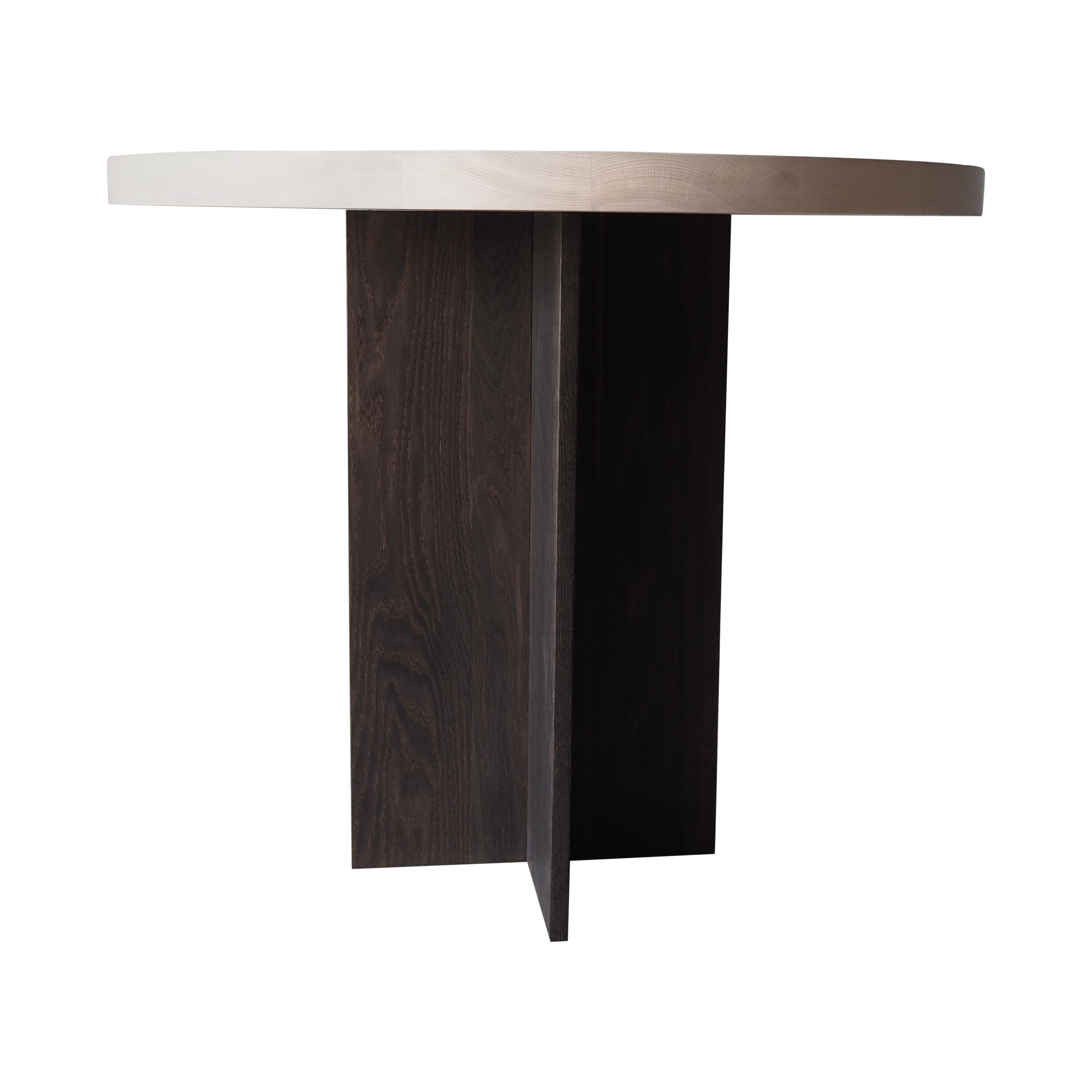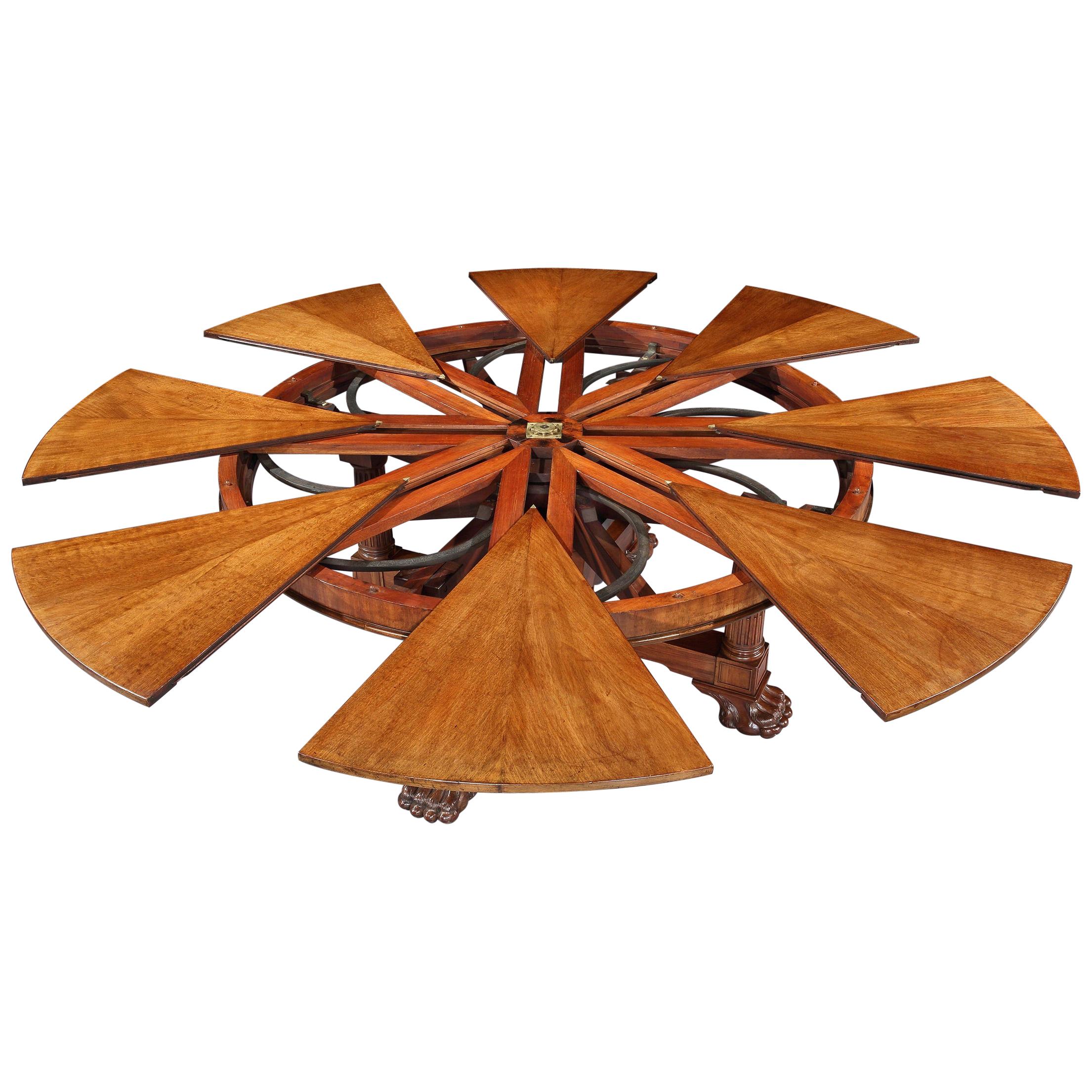Items Similar to Expanding Jupe Dining Table by Johnstone and Jeanes
Video Loading
Want more images or videos?
Request additional images or videos from the seller
1 of 7
Expanding Jupe Dining Table by Johnstone and Jeanes
About the Item
This exceptionally rare circular expanding dining table was designed by Robert Jupe and crafted by the English cabinetmakers Johnstone & Jeanes, successors to Johnstone, Jupe & Co. One of only a handful known from the firm, this table illustrates the Victorian era's quest to combine technical innovation with superb and beautiful craftsmanship. Complete with its original leaves, the table’s circular top is formed from eight separate segments. When the top is rotated, an ingenious swivel mechanism causes the sections to diverge, allowing a set of small or large leaves to be inserted for an adjustable increase in size.
The design for the table was patented by Robert Jupe in 1835, who had envisioned “an improved expanding table so constructed that the sections composing its surface may be caused to diverge from a common center and that the spaces caused thereby may be filled up by inserting leaves or filling pieces.” The first of these fascinating tables were created between 1835 and 1840 during his partnership with John Johnstone and their firm of Johnstone, Jupe & Co. in London. Jupe left the company in 1840, after which the firm changed its name due to a new partnership and became Johnstone & Jeanes. The firm would eventually achieve international fame for its remarkable designs, exhibiting a "circular table made on the expanding principle" like this one at the Great Exhibition of 1851.
Jupe was not alone in his fascination with combining the technical merits of engineering and mechanics with the more artful pursuit of cabinet making. The first half of the 19th century saw a prolific increase in the popularity of applying new ideas to furniture principles, which allowed furniture to serve many purposes. The resulting “patent” furniture was practical and refined, although none so much as this remarkable and quite stunning table which is equally suited for intimate gatherings or large, formal dinners.
Features brass Johnstone & Jeanes plaque
Circa 1850
Measures: 65" diameter x 29 3/4" high
93" diameter when fully expanded
Click here to view a video of this item.
- Creator:Robert Jupe (Designer)
- Dimensions:Height: 29.75 in (75.57 cm)Diameter: 93 in (236.22 cm)
- Style:Victorian (Of the Period)
- Materials and Techniques:
- Place of Origin:
- Period:
- Date of Manufacture:circa 1850
- Condition:General maint. and upkeep expected for an item of this age.
- Seller Location:New Orleans, LA
- Reference Number:
About the Seller
5.0
Recognized Seller
These prestigious sellers are industry leaders and represent the highest echelon for item quality and design.
Established in 1912
1stDibs seller since 2010
93 sales on 1stDibs
Typical response time: 7 hours
- ShippingRetrieving quote...Ships From: New Orleans, LA
- Return PolicyThis item cannot be returned.
More From This SellerView All
- Regency-Era Card TableLocated in New Orleans, LAThis ingenious late Regency card table was designed with both beauty and entertainment in mind. When not in use, its folded D-shaped top sits against the wall providing an elegant si...Category
Antique Early 19th Century English Regency Game Tables
MaterialsWood
- Incredible English Mahogany Seven-Pedestal Dining TableLocated in New Orleans, LAMeasuring over 30 feet in length, this tremendous and highly versatile English dining table is the greatest. It has the ability to transform to a multitude of sizes to fit any occasi...Category
Antique 19th Century British Neoclassical Dining Room Tables
MaterialsBrass
- Russian Malachite and Pietre Dure PlinthsLocated in New Orleans, LAThe exquisite art of pietre dure is at its absolute finest in this spectacular pair of Russian ormolu and malachite plinths. True works of art of the Restauration period, these plinths each feature a matching pietre dure mosaic crafted of the finest stones, all chosen to create a sense of depth and dimensionality in the final work. Depicting an onyx vase with tulips, roses, daffodils, magnolia and other flowers, these pietre dure panels are among the finest examples of this ancient art we have seen. The pietre dure is complemented by malachite panels of the highest quality, exhibiting exceptional depth through its extraordinary cellular structure. Malachite is one of Russia’s most precious stones, and its presence in these plinths indicates commission and ownership by an individual of considerable status. Mounted in an excellent stepped ormolu base, these plinths originally served as bases for vases or candelabra. The overall execution and appearance of these plinths is very characteristic of the taste associated with the immensely wealthy collector Nicolas Demidoff. As early as 1806, Demidoff had commissioned the Parisian goldsmith Henri August to supply a guéridon; in 1819, he ordered famed French bronzier Pierre-Philippe Thomire to supply mounts for a massive malachite vase (now in the Metropolitan Museum of Art, New York), as well as a console table with legs in the form of Nike. Other commissions included a table given as a gift to Grand Duke Leopoldo II of Florence, now in the Pitti Palace. Demidoff eventually settled in Florence in 1822 and became Russian minister to the Tuscan Court. Elevated to the rank of Count of San Donato by the Grand Duke, he built a magnificent villa at San Donato on the site of lands formerly owned by the Medici. The villa was later inherited by Anatole, his son, Prince of San Donato, and there are records which confirm transactions he had with the Opificio delle Pietre Dure. The 19th century proved to be the golden age of Russian malachite. The stone became a sign of prestige and a token of wealth, so much so that Russian papers of the time wrote: "To afford having a big piece wrought in malachite is synonymous to owning diamonds." Year after year the Russian (Romanov) treasury paid increasingly unreasonable prices to hoard the best malachite, much of which went into Romanov palaces and extravagant objets d'art. The Hermitage Museum possesses a collection of over two hundred examples of this “palatial” malachite...Category
Antique 19th Century Russian Pedestals
MaterialsMalachite, Ormolu
- French Ormolu PedestalLocated in New Orleans, LATremendous size and exquisite ormolu detailing distinguish this important 19th-century French pedestal. Crafted of ebony and ebonized woods, this outstanding fixture boasts intricate brass inlay and bold ormolu of exceptional quality on all four sides. Standing just over six feet tall and raised upon ormolu lion...Category
Antique 19th Century French Other Pedestals
MaterialsBronze, Ormolu
- 19th Century Exhibition Model of Expanding Table by Samuel HawkinsBy Samuel HawkinsLocated in New Orleans, LAA masterpiece of both cabinetmaking and mechanical engineering, this one-of-a-kind expanding table was crafted by the renowned cabinetmaker Samuel Hawkins of London for the Great Exhibition of 1851. Diminutive in size, the fascinating table was designed as a model to demonstrate Hawkins’ innovative patent screw movement to visitors of the Exhibition – six million people in total over five months. It was exhibited again a century later at the Victoria & Albert Museum during the Festival of Britain, an event intended “to symbolise two main qualities of the national character: realism and strength on the one hand, and, on the other, independence and imagination” (Catalogue of the Exhibition, 1951, p.117). To this day, the miniature masterpiece demonstrates the quest of English furniture makers to combine technical innovation with superb craftsmanship. Displaying exceptional ingenuity, Hawkins’ wind-out screw mechanism allowed one to extend the table’s base to accommodate concentric leaves with the simple crank of a handle. It is based on the inventive expanding table originally designed by Robert Jupe in 1835, which used a swivel mechanism to separate sections of the tabletop and allow for segmented leaves to be inserted. Hawkins’ tabletop, on the other hand, extends outwards directly from the center in order to accommodate additional leaves around its diameter. This unique design allowed the mechanism to also smoothly operate on rectangular tables, which could be wound out from the middle to allow for more table space. Hawkins was not alone in his endeavor to combine the technical merits of engineering and mechanics with the most artful pursuit of cabinetmaking. The first half of the 19th century saw a prolific increase in the popularity of applying new ideas to traditional furniture principles, which allowed furniture to serve many purposes. The resulting “patent” furniture was practical and refined, though few were as innovative as Hawkins’ prodigious design. Carved with the year of the Exhibition on the beautifully designed pedestal base, the table is a testament to the significance of this innovation. The model is mentioned in detail in the catalog of the Great Exhibition of 1851, the first international exhibition of industry, manufacturing, and science. Held at London’s dazzling Crystal Palace, its visitors were treated to exhibits from around the globe, including feats of engineering, innovations in industry, and marvels of design. Queen Victoria herself was a frequent visitor, along with her husband, Prince Albert, and others including Charlotte...Category
Antique 19th Century English Other Tables
MaterialsMahogany
- American Oak Dining Suite by R.J. HornerBy R.J. Horner & Co.Located in New Orleans, LAThis outstanding 13-piece Victorian dining suite by R.J. Horner of New York boasts intricate hand carving rarely seen in furnishings of the era....Category
Antique 19th Century American Victorian Dining Room Sets
MaterialsOak
You May Also Like
- Rare & Early Jupe Expanding Dining Table by Johnstone & JeanesBy Johnstone, Jeanes & Co.Located in London, GBA Rare 'Jupe's' Extensible Mechanical Action Circular Dining Table By Johnstone & Jeanes of New Bond Street Together with its original Leaf Cabinet By Johnstone & Jeanes Constructe...Category
Antique 19th Century English Dining Room Tables
MaterialsMahogany
- Oak and Beech Round Pedestal Dining or Entry Table by MSJ FurnitureBy MSJ FurnitureLocated in Vancouver, BCThis beech table with blackened oak base is perfect for an eating area or entryway. The tabletop is beech that has been bleached and white washed to leave a dazzling finish. The oak...Category
2010s Modern Dining Room Tables
MaterialsBeech, Oak
- Oak and Beech Round Pedestal Dining or Entry Table by MSJ FurnitureBy MSJ FurnitureLocated in Vancouver, BCThis beech table with oak base is perfect for a small eating area or entryway. The tabletop is beech that has been bleached and white washed to leave a dazzling finish. The oak bas...Category
2010s Modern Dining Room Tables
MaterialsBeech, Oak
- Architectural Italian Dining Table with Stone and GlassLocated in Waalwijk, NLDining table, stone, glass, Italy, 1970s This stone and glass centre table is exemplary for the postmodern design of the postwar Italian era. This stone pedestal table has a archit...Category
Vintage 1970s Italian Post-Modern Dining Room Tables
MaterialsStone
- Very Rare 19th Century Extending Jupe Table by Maple & CoBy Robert Jupe, Maple & Co.Located in London, GBA very rare ‘Jupe’s’ extensible mechanical action circular dining table By Maple & Co Constructed in mahogany, rising from four ‘lions paw’ feet, which support four reeded and st...Category
Antique 19th Century English Dining Room Tables
MaterialsMahogany
- Rare Italian Dining Table by Paolo Buffa in BrassBy Paolo BuffaLocated in Milano, ITImportant Italian dining table designed by the great master Paolo Buffa in the 1950s. Beautifully made by the Italian manufacture of the time. Features important lines and great wood...Category
Vintage 1950s Italian Mid-Century Modern Dining Room Tables
MaterialsBrass
Recently Viewed
View AllMore Ways To Browse
Up And Up Dining Table
Antique Brass Dining Table
Used Pedestals
Antique Dining Table Designs
Antique Design Dining Table
Dining Table Antique Design
Made To Measure Dining Tables
Rare Antique Dining Table
Antique Dining Room Dining Tables And Sets
Half Dining Table
Great Room Ideas
Antique Circular Dining Tables
Circular Antique Dining Table
Circular Dining Table Antique Furniture
Rare Large Table Dining Table
Rare Large Dining Table
Antique Like Dining Table
Antique Top Dining Circular Table





